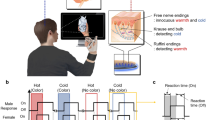Abstract
We present LiquidReality, a wearable system that simulates wetness sensations directly on the user’s face for immersive virtual reality applications. The LiquidReality system consists of a headmounted display integrated with thermal and vibrotactile modules that provides co-located haptic feedback with the displayed visuals. With this system, we conducted a preliminary study that evaluated nine types of thermal and thermal/vibrotactile stimuli to induce a wetness sensation on the user’s face. Our results indicate that thermal only stimuli and low frequency vibrotactile stimuli (combined with thermal) induced better wetness perception. Next, using the results from this preliminary study, we evaluated the immersion enhancement when using the LiquidReality system in combination with related visuals. The results indicate that using the LiquidReality system with related visuals, enhances the level of immersion for the user.
Access this chapter
Tax calculation will be finalised at checkout
Purchases are for personal use only
Similar content being viewed by others
References
Abzu (2016). http://www.abzugame.com/
Bach-y-Rita, P., Kercel, S.W.: Sensory substitution and the human machine interface. Trends Cognit. Sci. 7(12), 541–546 (2003). http://www.sciencedirect.com/science/article/pii/S1364661303002900
Blum, L., Broll, W., Müller, S.: Augmented reality under water. In: SIGGRAPH 2009: Posters, SIGGRAPH 2009, pp. 97:1–97:1. ACM, New York (2009). http://doi.acm.org/10.1145/1599301.1599398
Chen, Z., Peiris, R.L., Minamizawa, K.: A thermal pattern design for providing dynamic thermal feedback on the face with head mounted displays. In: Proceedings of the Eleventh International Conference on Tangible, Embedded, and Embodied Interaction, TEI 2017, pp. 381–388. ACM, New York (2017). http://doi.acm.org/10.1145/3024969.3025060
Filingeri, D., Fournet, D., Hodder, S., Havenith, G.: Why wet feels wet? a neurophysiological model of human cutaneous wetness sensitivity. J. Neurophysiol. 112(6), 1457–1469 (2014)
Gugenheimer, J., Wolf, D., Eiriksson, E.R., Maes, P., Rukzio, E.: Gyrovr: simulating inertia in virtual reality using head worn flywheels. In: Proceedings of the 29th Annual Symposium on User Interface Software and Technology, UIST 2016, pp. 227–232. ACM, New York (2016). http://doi.acm.org/10.1145/2984511.2984535
Halvey, M., Wilson, G., Brewster, S.A., Hughes, S.A.: Perception of thermal stimuli for continuous interaction. In: CHI EA 2013, pp. 1587–1592 (2013)
Jain, D., Sra, M., Guo, J., Marques, R., Wu, R., Chiu, J., Schmandt, C.: Immersive scuba diving simulator using virtual reality. In: Proceedings of the 29th Annual Symposium on User Interface Software and Technology, UIST 2016, pp. 729–739. ACM, New York (2016). http://doi.acm.org/10.1145/2984511.2984519
Jones, L.A., Ho, H.N.: Warm or cool, large or small? the challenge of thermal displays. IEEE Trans. Haptics 1(1), 53–70 (2008)
Minamizawa, K., Kakehi, Y., Nakatani, M., Mihara, S., Tachi, S.: Techtile toolkit: a prototyping tool for design and education of haptic media. In: Proceedings of the 2012 Virtual Reality International Conference, VRIC 2012, pp. 26:1–26:2. ACM, New York (2012). http://doi.acm.org/10.1145/2331714.2331745
Myles, K., Kalb, J.T.: Vibrotactile sensitivity of the head, U.S. Army Research Laboratory (2009)
Parsons, K.: Human Thermal Environments: The Effects of Hot, Moderate, and Cold Environments on Human Health, Comfort, and Performance, 3rd edn. CRC Press Inc., Boca Raton (2014)
Peiris, R.L., Peng, W., Chen, Z., Chan, L., Minamizawa, K.: Thermovr: exploring integrated thermal haptic feedback with head mounted displays. In: Proceedings of the 2017 CHI Conference on Human Factors in Computing Systems, CHI 2017, pp. 5452–5456. ACM, New York (2017). http://doi.acm.org/10.1145/3025453.3025824
Ranasinghe, N., Jain, P., Tolley, D., Karwita, S., Yilei, S., Do, E.Y.L.: Ambiotherm: simulating ambient temperatures and wind conditions in vr environments. In: Proceedings of the 29th Annual Symposium on User Interface Software and Technology, UIST 2016 Adjunct, pp. 85–86. ACM, New York (2016). http://doi.acm.org/10.1145/2984751.2985712
Shibahara, M., Sato, K.: Illusion of wet sensation by controlling temperature and softness of dry cloth. In: Bello, F., Kajimoto, H., Visell, Y. (eds.) EuroHaptics 2016. LNCS, vol. 9774, pp. 371–379. Springer, Cham (2016). https://doi.org/10.1007/978-3-319-42321-0_34
Witmer, B.G., Singer, M.J.: Measuring presence in virtual environments: A presence questionnaire. Presence: Teleoper. Virtual Environ. 7(3), 225–240 (1998). https://doi.org/10.1162/105474698565686
Yamashita, S., Zhang, X., Rekimoto, J.: Aquacave: Augmented swimming environment with immersive surround-screen virtual reality. In: Proceedings of the 29th Annual Symposium on User Interface Software and Technology, UIST 2016 Adjunct, pp. 183–184. ACM, New York (2016). http://doi.acm.org/10.1145/2984751.2984760
Acknowledgment
This work was supported by the JSPS Kakenhi (JP18K18094) and the JST ACCEL Embodied Media project (JPMJAC1404), Japan.
Author information
Authors and Affiliations
Corresponding author
Editor information
Editors and Affiliations
Rights and permissions
Copyright information
© 2018 Springer International Publishing AG, part of Springer Nature
About this paper
Cite this paper
Peiris, R.L., Chan, L., Minamizawa, K. (2018). LiquidReality: Wetness Sensations on the Face for Virtual Reality. In: Prattichizzo, D., Shinoda, H., Tan, H., Ruffaldi, E., Frisoli, A. (eds) Haptics: Science, Technology, and Applications. EuroHaptics 2018. Lecture Notes in Computer Science(), vol 10894. Springer, Cham. https://doi.org/10.1007/978-3-319-93399-3_32
Download citation
DOI: https://doi.org/10.1007/978-3-319-93399-3_32
Published:
Publisher Name: Springer, Cham
Print ISBN: 978-3-319-93398-6
Online ISBN: 978-3-319-93399-3
eBook Packages: Computer ScienceComputer Science (R0)





